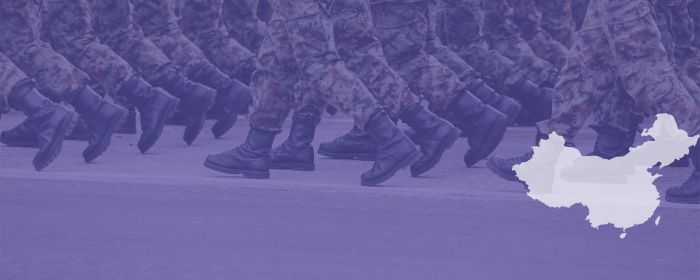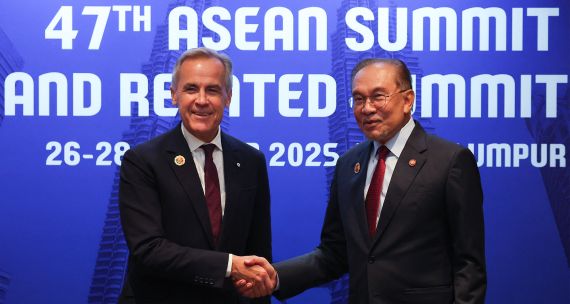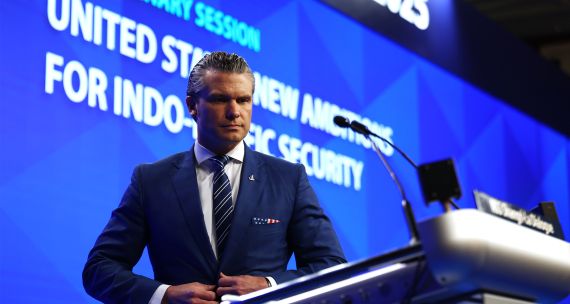The Takeaway
China’s three days of military drills in the Taiwan Strait — following a meeting between Taiwanese President Tsai Ing-wen and U.S. House Speaker Kevin McCarthy in California — did little to intimidate most Taiwanese. But the nuances of the latest drill may hint at an approach by Beijing to influence Taiwan's upcoming presidential elections.
In Brief
The Eastern Theater Command of China's People's Liberation Army (PLA) announced on April 8 that it would carry out military patrols and a 'Joint Sword' drill — “swift and decisive” actions involving multiple army branches — from April 8 to 10 in the seas surrounding Taiwan. Rehearsing to "take control over the waters, sky, and information," the PLA Navy conducted mock sea assaults, long-range deterrence drills, and anti-missile exercises. Warplanes from the PLA’s Air Force flew a total of 232 sorties — 134 of which crossed Taipei's self-proclaimed “Taiwan Strait median line” — during the three-day blockade simulation.
Though Beijing did not officially state what prompted the drills, the PLA’s latest military muscle-flexing is widely seen as a response to Taiwanese President Tsai Ing-wen's April 5 meeting with U.S. House Speaker Kevin McCarthy in Los Angeles. Tsai met with McCarthy on her way back from an official trip to visit allies in Central America. While the Chinese Ministry of Foreign Affairs termed the Tsai-McCarthy meeting as “a collusion between U.S. and Taiwan” to “upgrade [their] substantive relations” and create tension, Taipei accused Beijing of “posing a serious threat to Taiwan’s security” and “escalating regional tensions.”
While the drills did little to disrupt day-to-day activities in Taiwan, the PLA’s offshore live-fire exercise on April 8 came within 50 kilometres of the Taiwan-governed Matsu Islands. Five days later, Taichung city in western Taiwan staged a civil defence and preparedness drill to rehearse disaster relief during a hypothetical PLA attack.
Implications
The meeting between Tsai and McCarthy, which Tsai described as an assurance of “[the U.S. Congress’s] unwavering support” for Taiwan, was the most high-profile meeting between American and Taiwanese politicians on American soil since the U.S. severed official ties with Taiwan in 1979. It did not come as a surprise that China, having vowed to retaliate if such a meeting took place, conducted military exercises in response.
Observers point out that the latest drills are smaller than those carried out in August 2022 over then-U.S. House Speaker Nancy Pelosi's visit to Taiwan. After Pelosi’s visit, China fired missiles over Taiwan’s main island. This time around, China showcased its new strike capabilities, including deploying its first domestically built ‘Shandong’ aircraft carrier near Taiwan and launching J-15 fighter jets from the carrier. The PLA said following the drills that it simulated precision-guided missile strikes on “key targets of the Taiwan island” — believed to be Taipei and Kaohsiung — and proved the PLA’s “multi-branch combat readiness” in a conflict scenario. Such exercises foreshadow what the PLA could deploy during an actual combat situation.
One reason for Beijing’s relatively restrained response is timing: Taiwan will hold presidential elections in nine months, Ma Ying-jeou (Tsai’s predecessor as president) just wrapped up a historic trip to mainland China, and China is emerging from economic disruptions brought on by COVID-19 restrictions.
Ma arrived in Taipei on April 7 after finishing his 12-day mainland tour, during which he promoted his interpretation of the ‘One China Principle’ and sought consensus with the Chinese Communist Party (CCP), his party’s former civil war enemy. Ma, the veteran former leader of opposition Kuomintang (KMT), urged the Democratic Progressive Party (DPP) government to "choose between peace and war” thoughtfully and not to put Taiwan’s safety in jeopardy.
Tsai, for her part, sees her trip to Central America and her meeting with McCarthy as wins, both of which could help cement the DPP’s image as a safeguard against Beijing’s influence. Far from isolating the island, provoking Taiwan militarily may draw more international allies to Taipei, and garner support on the island for Tsai’s pro-independence DPP.
What's Next
- Dealing with the ‘people factor’
While most people in Taiwan were indifferent to the PLA drills, some experts are concerned that China’s regularized military activities around Taiwan may “lull people into a false sense of security.” The CCP, meanwhile, is hoping for a KMT win in the presidential elections and is banking — perhaps in vain — that its ‘carrot-and-stick’ strategy will dissuade people from voting for the DPP.
- Is an economic blockade still an option?
The Chinese Ministry of Commerce announced on April 12 that it is initiating an investigation into Taiwan's alleged trade barriers on 2,455 mainland products, with an extended deadline set for January 12, 2024 — a day prior to Taiwan’s presidential elections. Some are worried that this rare move signals a higher likelihood of an economic blockade by Beijing.
- International players on the watch
Other than the U.S., which recently deployed USS Nimitz in the vicinity of Taiwan, Japan followed the PLA activities “with great interest” due to its proximity to Taiwan. French President Emmanuel Macron and European Commission President Ursula von der Leyen, who were on their official visits to China during the time, called for maintaining the status quo, and stressed that Europe must remain strategically autonomous in crafting policies on Taiwan.
• Produced by CAST’s Greater China team: Maya Liu (Program Manager); Liam Lau (Analyst); and Dustin Lo (Analyst).




